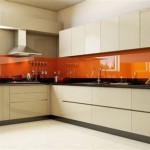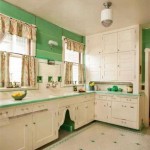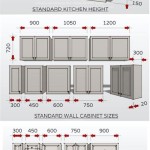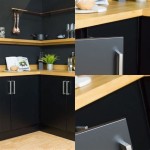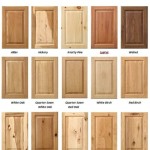Using Shelves Instead of Kitchen Cabinets
Open shelving in kitchens has become a popular design choice, offering a modern and airy alternative to traditional closed cabinetry. This shift reflects a move towards minimalism and a desire for more visually accessible storage. While cabinets provide concealed storage, shelves offer a unique opportunity to showcase prized dishware, cookbooks, and decorative items, effectively integrating them into the kitchen's aesthetic.
Benefits of Open Shelving
Open shelving provides several advantages, contributing to both the functionality and visual appeal of a kitchen:
- Enhanced Accessibility: Items are readily available, eliminating the need to open and close cabinet doors.
- Visual Appeal: Shelves create a sense of openness and spaciousness, making the kitchen feel larger.
- Display Opportunity: Favorite dishes and glassware can be showcased, adding personality and style to the space.
- Cost-Effectiveness: Shelving systems are generally less expensive than traditional cabinetry.
Considerations Before Making the Switch
Before replacing cabinets with shelves, several factors need to be considered to ensure the transition is practical and aesthetically pleasing:
- Storage Needs: Assess the quantity of kitchenware that needs storage to ensure adequate shelf space.
- Kitchen Style: Open shelving complements certain design aesthetics (e.g., farmhouse, modern) more effectively than others.
- Maintenance: Open shelves require more frequent dusting and cleaning than enclosed cabinets.
- Organization: Maintaining a tidy and organized appearance is crucial with open shelving as everything is visible.
Choosing the Right Shelves
The selection of appropriate shelving is essential for both functionality and aesthetics. Various materials and styles are available to match different kitchen designs and individual preferences.
- Material: Wood, metal, and glass are common choices, each offering a distinct look and feel.
- Style: Floating shelves, bracket shelves, and built-in shelves offer varying levels of support and visual impact.
- Size and Depth: Consider the size and weight of the items to be stored when selecting shelf dimensions.
Maximizing Shelf Space
Strategic organization is key to maximizing the functionality of open shelving. Implementing organizational techniques can ensure efficient use of space while maintaining a visually appealing display.
- Vertical Space: Utilize vertical space effectively by incorporating shelves of varying heights.
- Grouping Similar Items: Group similar items together (e.g., glasses, plates) for a cohesive and organized look.
- Storage Containers: Use baskets and containers to store smaller items and maintain a clutter-free appearance.
Styling Open Shelves
Open shelves provide an opportunity to express personal style and enhance the overall kitchen aesthetic. Thoughtful styling can transform shelves into a focal point of the kitchen.
- Color Coordination: Arrange items by color to create a visually appealing and harmonious display.
- Mixing Materials: Combine different materials (e.g., ceramic, wood, glass) to add texture and visual interest.
- Incorporating Decorative Elements: Add plants, cookbooks, or artwork to personalize the space and add character.
Integrating Open Shelving with Existing Cabinets
Open shelving can be effectively integrated with existing cabinetry to create a balanced and functional kitchen design. Combining the two storage solutions provides both concealed and open storage options.
- Strategic Placement: Position shelves strategically to complement existing cabinetry and optimize workflow.
- Visual Balance: Balance the open shelving with closed cabinetry to avoid a cluttered or overwhelming appearance.
- Consistent Style: Choose shelving that complements the style and finish of existing cabinets for a cohesive look.
Maintaining Open Shelves
Maintaining open shelves requires regular cleaning and organization to prevent dust buildup and maintain a tidy appearance. Implementing a consistent cleaning routine will ensure the shelves remain a visually appealing feature of the kitchen.
- Regular Dusting: Dust shelves frequently to prevent dust accumulation on displayed items.
- Cleaning Spills Promptly: Address spills immediately to avoid staining or damage to shelves and stored items.
- Periodic Reorganization: Reorganize shelves periodically to maintain a fresh and organized appearance.
Lighting Open Shelves
Proper lighting can enhance the visual appeal of open shelving and highlight displayed items. Incorporating appropriate lighting solutions can create a warm and inviting atmosphere in the kitchen.
- Under-Shelf Lighting: Install under-shelf lighting to illuminate displayed items and create a warm ambiance.
- Accent Lighting: Use accent lighting to highlight specific areas or items on the shelves.
- Natural Light: Consider the natural light in the kitchen when positioning shelves to maximize visibility and minimize glare.

Why I Combined Open Shelves And Cabinets In My Kitchen Remodel

Open Shelving Vs Upper Cabinets In Kitchen Pros And Cons

Open Shelving Vs Upper Cabinets In Kitchen Pros And Cons
Open Shelving Is Trendy But It S A Home Decor Mistake That Should Go

Open Shelving In The Kitchen Great Debate Lauren Liess

65 Ideas Of Using Open Kitchen Wall Shelves Shelterness

House Home Open Shelves Or Closed Upper Cabinets The Debate Is On

Cabinets Vs Open Shelving Which Is Better For Your Kitchen Abc Glass Mirror

Of Kitchen Cabinets Open Shelves Cabinet City And Bath

Should You Use Open Shelves In The Kitchen
Related Posts

